
This short and sweet 5E lesson helps students explain the role of gravity in the formation of the solar system and in orbital motion (6.2c).
- Subject:
- Earth and Space Systems
- Material Type:
- Lesson
- Author:
- Melissa Bills
- Date Added:
- 03/11/2021

This short and sweet 5E lesson helps students explain the role of gravity in the formation of the solar system and in orbital motion (6.2c).
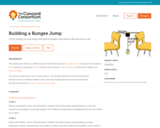
A bungee jump involves jumping from a tall structure while connected to a large elastic cord. Design a bungee jump that is "safe" for a hard-boiled egg. Create a safety egg harness and connect it to a rubber band, which is your the "bungee cord." Finally, attach your bungee cord to a force sensor to measures the forces that push or pull your egg.
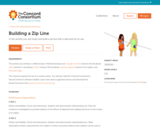
A zip line is a way to glide from one point to another while hanging from a cable. Design and create a zip line that is safe for a hard-boiled egg. After designing a safety egg harness, connect the harness to fishing line or wire connected between two chairs of different heights using a paper clip. Learn to improve your zip line based on data. Attach a motion sensor at the bottom of your zip line and display a graph to show how smooth a ride your egg had!
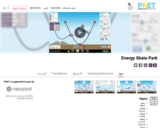
Learn about conservation of energy with a skater dude! Build tracks, ramps and jumps for the skater and view the kinetic energy, potential energy and friction as he moves. You can also take the skater to different planets or even space!
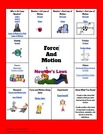
HyperDocs are GoogleDocs that provide an interactive experience for students to explore linked resources about a topic. This HyperDoc, created by Angela Wilson, provides students YouTube videos, interactive simulations, StudyJams, and games all about force, motion, and gravity. **Please be sure to make a copy of the Doc before using.**
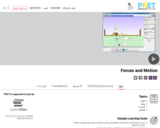
Explore the forces at work when you try to push a filing cabinet. Create an applied force and see the resulting friction force and total force acting on the cabinet. Charts show the forces, position, velocity, and acceleration vs. time. View a Free Body Diagram of all the forces (including gravitational and normal forces).

Pump gas molecules to a box and see what happens as you change the volume, add or remove heat, change gravity, and more. Measure the temperature and pressure, and discover how the properties of the gas vary in relation to each other.
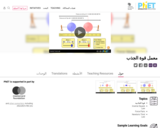
Visualize the gravitational force that two objects exert on each other. Change properties of the objects in order to see how it changes the gravity force.
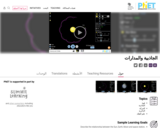
Move the sun, earth, moon and space station to see how it affects their gravitational forces and orbital paths. Visualize the sizes and distances between different heavenly bodies, and turn off gravity to see what would happen without it!

Isaac Newton's famous thought experiment about what would happen if you launched a cannon from a mountaintop at a high velocity comes to life with an interactive computer model. You are charged with the task of launching a satellite into space. Control the angle and speed at which the satellite is launched, and see the results to gain a basic understanding of escape velocity.
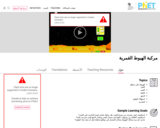
Can you avoid the boulder field and land safely, just before your fuel runs out, as Neil Armstrong did in 1969? Our version of this classic video game accurately simulates the real motion of the lunar lander with the correct mass, thrust, fuel consumption rate, and lunar gravity. The real lunar lander is very hard to control.
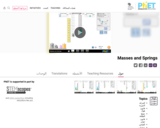
A realistic mass and spring laboratory. Hang masses from springs and adjust the spring stiffness and damping. You can even slow time. Transport the lab to different planets. A chart shows the kinetic, potential, and thermal energy for each spring.
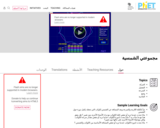
Build your own system of heavenly bodies and watch the gravitational ballet. With this orbit simulator, you can set initial positions, velocities, and masses of 2, 3, or 4 bodies, and then see them orbit each other.

Video Description: Engineering design and technology development support scientific discovery. Learn about the roles engineers and scientists play when working together on NASA missions like the James Webb Space Telescope and how science and engineering take turns pushing each other to move exploration forward. Video Length: 4:16.NASA eClipsTM is a suite of online student-centered, standards-based resources that support instruction by increasing STEM literacy in formal and nonformal settings. These free digital and downloadable resources inform and engage students through NASA-inspired, real-world connections.NASA eClips Launchpad videos focus on NASA innovations and the technology that take us into the future. These segments support project-based and problem-based learning experiences in science, mathematics, and career and technical education classrooms.

Video Description: Each of us is made from star stuff. But how are stars formed? Take a closer look at the life cycles of stars and learn where stars come from, how they change, and what happens to stars when their lives come to an end. Find out about your connection to the cosmos. Video Length: 6:00.NASA eClipsTM is a suite of online student-centered, standards-based resources that support instruction by increasing STEM literacy in formal and nonformal settings. These free digital and downloadable resources inform and engage students through NASA-inspired, real-world connections.NASA eClips Launchpad videos focus on NASA innovations and the technology that take us into the future. These segments support project-based and problem-based learning experiences in science, mathematics, and career and technical education classrooms.

Video Description: The Moon impacts Earth through tides and moonlight. NASA missions to the Moon continue to help us discover more about our nearest neighbor. Learn more about Moon mapping and resources. Video Length: 2:49. NASA eClipsTM is a suite of online student-centered, standards-based resources that support instruction by increasing STEM literacy in formal and nonformal settings. These free digital and downloadable resources inform and engage students through NASA-inspired, real-world connections.NASA eClips Our World videos (grades 3-5) help students understand the differences between science (the natural world) and engineering (the designed world). These video segments supplement elementary learning objectives not only in science, technology, engineering and mathematics, but also in reading, writing, visual and performing arts.

Video Description: Picture this. NASA sends a spacecraft to land on an asteroid, grab a piece of that asteroid, and then send that sample back to Earth to study. Learn more about all that NASA can learn about the formation of the Solar System from the close encounter of OSIRIS-REx with near-Earth asteroid Bennu. Video Length: 3:55.NASA eClipsTM is a suite of online student-centered, standards-based resources that support instruction by increasing STEM literacy in formal and nonformal settings. These free digital and downloadable resources inform and engage students through NASA-inspired, real-world connections.NASA eClips Real World segments (grades 6-8) connect classroom mathematics to 21st Century careers and innovations. They are designed for students to develop an appreciation for mathematics through real-world problem solving.

Video Description: How does NASA test ideas, like the Mars Helicopter, before they are even built? Find out more about this revolutionary helicopter and how NASA uses mathematical modeling to turn complex ideas into solvable equations that help shape future missions. Video Length: 3:20.NASA eClipsTM is a suite of online student-centered, standards-based resources that support instruction by increasing STEM literacy in formal and nonformal settings. These free digital and downloadable resources inform and engage students through NASA-inspired, real-world connections.NASA eClips Real World segments (grades 6-8) connect classroom mathematics to 21st Century careers and innovations. They are designed for students to develop an appreciation for mathematics through real-world problem solving.

Video Description: What defines the limits of the solar system? Where does the Oort Cloud fit within this defined space? Paul Chodas, from NASA's Near Earth Object Program, answers these questions and fills us in on some of NASA's missions and explorations that have helped shape our understanding of the solar system. Video Length: 2:22.NASA eClipsTM is a suite of online student-centered, standards-based resources that support instruction by increasing STEM literacy in formal and nonformal settings. These free digital and downloadable resources inform and engage students through NASA-inspired, real-world connections.NASA eClips Real World segments (grades 6-8) connect classroom mathematics to 21st Century careers and innovations. They are designed for students to develop an appreciation for mathematics through real-world problem solving.

Video Description: In addition to planets and their moons, there are many small bodies orbiting the Sun. How did these bodies form? Learn more about comets and asteroids and the role these play in our Solar System, as well as NASA's Rosetta and NEOWISE missions. Video Length: 3:09.NASA eClipsTM is a suite of online student-centered, standards-based resources that support instruction by increasing STEM literacy in formal and nonformal settings. These free digital and downloadable resources inform and engage students through NASA-inspired, real-world connections.NASA eClips Real World segments (grades 6-8) connect classroom mathematics to 21st Century careers and innovations. They are designed for students to develop an appreciation for mathematics through real-world problem solving.